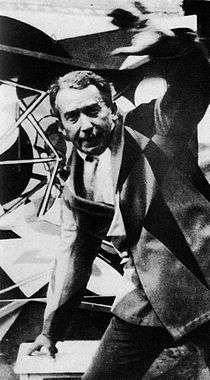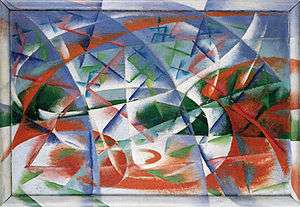Giacomo Balla
| Giacomo Balla | |
|---|---|
 | |
| Born |
Giacomo Joseph Balla July 18, 1871 Turin, Italy |
| Died |
March 1, 1958 (aged 86) Rome, Italy |
| Nationality | Italian |
| Known for | Painting, Poet |
| Movement | Futurism |
| Awards | N/A |
Giacomo Balla (18 July 1871 – 1 March 1958) was an Italian painter, art teacher and poet best known as a key proponent of Futurism. In his painting he depicted light, movement and speed.
Biography
Giacomo Balla was born in Turin, in the Piedmont region of Italy. He was the son of a photographer [1] and as a child studied music.
At age nine, after the death of his father, he gave up music and began working in a lithograph print shop. By age 20, his interest in visual art had developed to such a level that he decided to study painting at local academies, and several of his early works were shown at exhibitions. Following academic studies at the University of Turin, Balla moved to Rome in 1895, where he met and later married Elisa Marcucci. For several years he worked in Rome as an illustrator, caricaturist and portrait painter. In 1899, his work was exhibited at the Venice Biennale, and in the ensuing years his art was shown at major exhibitions in Rome and Venice, as well as in Munich, Berlin and Düsseldorf, at the Salon d'Automne in Paris, and at galleries in Rotterdam.
%2C_Albright-Knox_Art_Gallery.jpg)
Around 1902, he taught Divisionist techniques to Umberto Boccioni and Gino Severini.[2] Influenced by Filippo Tommaso Marinetti, Giacomo Balla adopted the Futurism style, creating a pictorial depiction of light, movement and speed. He was a signatory of the Futurist Manifesto in 1910, and he began to design Futurist furniture, as well as so-called Futurist "antineutral" clothing. Typical for his new style of painting is Dynamism of a Dog on a Leash (1912) and his 1914 work Abstract Speed + Sound (Velocità astratta + rumore). In 1914, Balla began working as a sculptor, creating, in 1915, the well-known work titled Boccioni's Fist.
During World War I, Balla's studio became a meeting place for young artists.
In 1935, he was made a member of Rome's Accademia di San Luca.
In 1955, Balla participated in the documenta 1 in Kassel.
He died on 1 March 1958.
Notable works
Balla's 1909 painting The Street Light typifies his exploration of light, atmosphere, and motion.[3]
Balla's most famous works, such as his 1912 Dynamism of a Dog on a Leash where efforts to express movement – and thus the passage of time – through the medium of painting. One of Balla's main inspirations was the chronophotography of Étienne-Jules Marey.[4][5][6]
Balla's 1912 The Hand of the Violinist depicts the frenetic motion of a musician playing, and draws on inspiration from Cubism and the photographic experiments of Marey and Eadweard Muybridge.[7] [8]
In his abstract 1912–1914 series Iridescent Interpenetration, Balla attempts to separate the experience of light from the perception of objects as such.[9]
Abstract Speed + Sound (1913–14) is a study of speed symbolised by the automobile. Originally, it may have been part of a triptych.[10]
Balla's 1914 series Mercury Passing Before the Sun depicts the November 17, 1914 transit of Mercury across the face of the Sun. Balla created at least a dozen versions and studies of this work.


Legacy
In 1987, some of his artworks were exhibited at documenta 8, an exhibition of modern art and contemporary art which takes place every five years in Kassel, Germany.
See also
- Works by Giacomo Balla
- Italian Futurism
References
- ↑ ...], [contributors Rachel Barnes (2001). The 20th-Century art book. (Reprinted. ed.). London: Phaidon Press. ISBN 0714835420.
- ↑ Coen, Ester (1989). Umberto Boccioni. New York: The Metropolitan Museum of Art. p. 272. ISBN 0870995227.
- ↑ "Giacomo Balla (1871-1958)". Encyclopedia of Visual Artists. Retrieved 19 July 2016.
- ↑ "Giacomo Balla". Encyclopædia Britannica. Retrieved 20 July 2016.
- ↑ Lubbock, Tom (September 3, 2009). "Great Works: Dynamism of A Dog on a Leash (1912) Giacomo Balla". The Independent. Retrieved 20 July 2016.
- ↑ Marta Braun: Giacomo Balla, Anton Giulio Bragaglia, and Etienne-Jules Marey. In: Vivien Greene (ed.): Italian Futurism 1909 - 1944. Reconstructing the Universe, Guggenheim Museum 2014, p.95-101 Braun states (p.96): "For Balla, perhaps the most photo-literate of the Futurist painters, both Marey's scientific analyses and Bragaglia's blurred trajectories presented an opportunity to move beyond his earlier, more realistic works."
- ↑ Bertrand, Sandra (July 24, 2014). "Invasion of the Italian Futurists". Highbrow Magazine. Retrieved 1 November 2016.
- ↑ Greenwald, Xico (April 22, 2014). "Back to the Futurism". New York Sun. Retrieved 1 November 2016.
- ↑ Poggi, Christine (2009). "Photogenic Abstraction: Giacomo Balla's Iridescent Interpenetrations". Inventing Futurism: The Art and Politics of Artificial Optimism. Princeton University Press. pp. 109–149. ISBN 9780691133706.
- ↑ "Giacomo Balla: Abstract Speed + Sound (Velocità astratta + rumore)". Peggy Guggenheim Collection. Retrieved 20 July 2016.
Further reading
- Maurizio Fagiolo Dell'Arco, Balla: The Futurist (1988)
- Vivien Greene (ed.): Italian Futurism 1909 - 1944. Reconstructing the Universe, Guggenheim Museum 2014, ISBN 978-0-89207-499-0
- Giovanni Lista, Balla, catalogue général de l’œuvre, vol. I, Edizioni della Galleria Fonte d’Abisso, Modène, 1982 ; vol. II, L’Age d’Homme, Lausanne, 1984
- Giovanni Lista,Le Futurisme : création et avant-garde, Éditions L’Amateur, Paris, 2001
- Giovanni Lista, Balla, la modernità futurista, Edizioni Skira, Milan, 2008
- Giovanni Lista, Giacomo Balla: futurismo e neofuturismo, Mudima, Milano, 2009.
- Giacomo Balla, Scritti futuristi, raccolti e curati da Giovanni Lista, Abscondita, Milan, 2010.
External links
| Wikiquote has quotations related to: Giacomo Balla |
- Guide to Balla's paintings, at Artcyclopedia
- Abstract Speed + Sound by Giacomo Balla, Guggenheim Museum
- Giacomo Balla's Biography- Guggenheim Museum
- Article on Italian Futurism exhibition at the Guggenheim Museum
| Wikimedia Commons has media related to Giacomo Balla. |